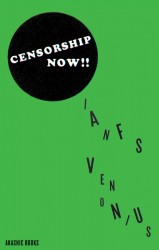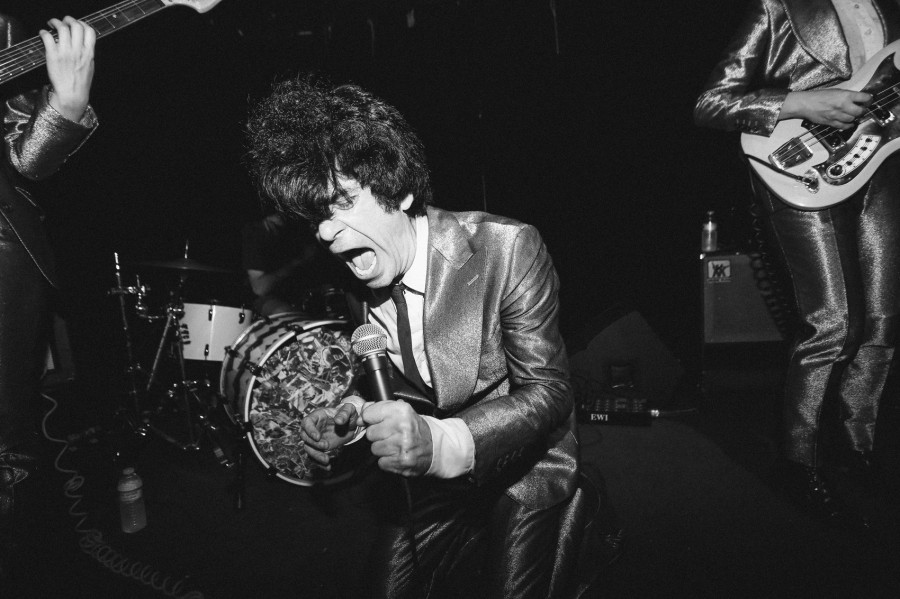Regular readers of Bandwidth.fm should not be unfamiliar with Ian Svenonius, the D.C. punk singer (The Make-Up, Nation Of Ulysses, Chain & the Gang, others) who writes essays and books when music isn’t enough.
 As expressive as Svenonius is, though, the musician doesn’t think everyone is entitled to an audience. He took that stance during his June appearance on WAMU 88.5’s The Kojo Nnamdi Show, and he drives it home in newest collection of essays, Censorship Now!!, out Nov. 3 on Akashic Books.
As expressive as Svenonius is, though, the musician doesn’t think everyone is entitled to an audience. He took that stance during his June appearance on WAMU 88.5’s The Kojo Nnamdi Show, and he drives it home in newest collection of essays, Censorship Now!!, out Nov. 3 on Akashic Books.
The man who once argued in song that “Music’s Not For Everyone” devotes a chapter of Censorship Now!! to the idea that rock ‘n’ roll’s “legacy machine” — including your favorite band’s attempt to reserve a place in the canon — must be stifled.
Excerpted from Censorship Now!! copyright 2015 by Ian F. Svenonius, used with permission of Akashic Books.
DIY was the byword through post-punk and on to the “indie” era. Now, with the economy destroyed by computers, DIY is no longer a philosophy as much as a requirement. Everyone is required to look after each aspect of their own art-making/proliferation because — ever since the Internet demonetized art, photos, film, writing and music — there are few resources to support adjunct workers and technicians.
DIY now extends from the production of records, fanzines and show-promoting to all aspects of the rock experience, including fandom itself. Once, people venerated others. Now, under indie’s DIY paradigm, people must venerate themselves. Historicization of the group is therefore now its own responsibility. Not only must the records and tours be DIY (arranged and administered by the bands themselves), but the hype itself — the historical biopics, the “remember when” nostalgia, the reunion demands and the reissue records — is all self-generated.
Ironically, The Beatles — the biggest group of all, whose “invasion” unwittingly ushered in the corporate takeover of rock ’n’ roll — started the DIY self-historicizing trend with their 1995 TV special Anthology, designed to hawk the group to an audience who had grown up without them.
The Beatles were, at the time of its making, three distinct and fractious individuals— as well as a deceased member who had been sainted in death after publicly disavowing the group and heaping scorn on their achievements for a full decade. Each Beatle’s competing agendas and recollections are on display; the group members are perverse and contrarian, with the exception of Paul, whose pride of the group’s songs, success and what they meant to people is resolute and unflinching. George, on the other hand, nurses old resentments, Ringo is a slightly melancholic bon vivant with a cranky, sentimental view, and of course Yoko Ono, John Lennon’s widow, is the anti-Beatle in many respects, who claimed not to know who The Beatles were or that the group even existed.
“For all of the punk rockers’ stoic claims to independence, societal rejection and aversion to fame, they really long to have their flesh rended by a Dionysian mob of shrieking Beatlemaniacs.”
John Lennon, meanwhile, is a ghost who hasn’t been absorbed into a modern context or narrative. Lennon is stuck in time as a ’70s self-help house-husband — isolated, manic-depressive and revisionist — shrilly denouncing the crimes of the Fab Four. Throughout, Paul tries to put a brave face on the malaise of the other members. The group is collectively hungover from the trauma of Beatlemania and the toll it took on them, the expectations and alienation it engendered.
Their myth, with all these conflicts muddying what would seem like a straightforward tale of unprecedented popular success and innovation, will continue to thrive, not in spite of these conflicts but because of them. Other, more stable groups — such as The Rolling Stones, The Who and Oasis — have contrived similar fractious interpersonal dynamics in order to give their own groups some Beatles-esque resonance, and thus generate more mystery, conjecture and sales.
Punk and indie rock’s DIY hagiographies, though, don’t suffer the same internal contradictions and therefore feel more like the desperate advertisements they are. Typically not nuanced by democratic infighting, they are usually dull veneration, utilizing hapless stand-ins as directors to pretend that every shot and quote wasn’t designated by the star of the film. These are often “crowdsourced”; paid for by the fans themselves before the abomination becomes public and makes money as a commercial item, propagating more revenue for the star-turned-“icon.”
Such a status for their star is what these films strive for, as “icon” is essentially a brand, and a brand is something that’s digestible to the fully detached, the otherwise oblivious; the reduction of the person to the slimmest, slightest object for the marginally engaged. This is self-objectification in the hunt for immortal status, like a poignant Greek myth wherein the hapless mortal, in a search for foreverness, reduces her or himself to a piece of plaster so as to have a place in the halls of Olympus.
For all of the punk rockers’ stoic claims to independence, societal rejection and aversion to fame, they really long to have their flesh rended by a Dionysian mob of shrieking Beatlemaniacs. The fearsome promise of these barely adolescent “maniacs,” occupying hotels, breaking police barriers and screaming nonstop for blood, constitutes a formative ur-text for the rocker, one which he or she can’t shake. Its cosmic portrait of danger, magic and Lord of the Flies anarchy figures centrally in the early programming of the group member, who wants, expects and needs some version of it. Therefore, the modern DIY band — faced with the nonchalant peer-fan — looks outward to the masses for their own “maniac” mob, and takes what it can get.
Ian Svenonius reads from Censorship Now!! Oct. 27 at Busboys and Poets on 14th Street NW. Elsewhere: Check out Bandwidth’s February interview with Svenonius, and read the musician on how NPR killed college rock.



Pingback: Arts Roundup: RIP Ed Walker Edition | Washington Metro Bugle()